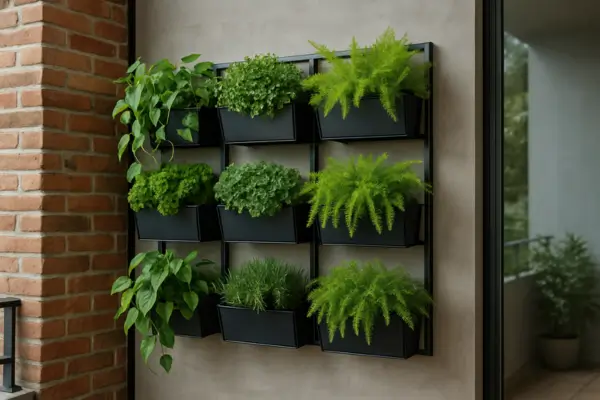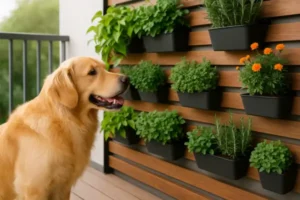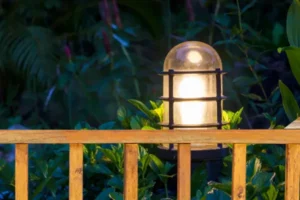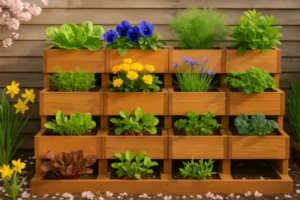Low-maintenance plants for vertical gardens on balconies are the perfect solution for anyone who wants the joy of a green space without the stress of daily upkeep. Whether you’re working with a compact city balcony or a small terrace, the right plants make all the difference.
A well-planned vertical garden adds life, shade, and beauty, even in tight spaces. And when you opt for plants that practically care for themselves, it becomes much easier to keep everything looking vibrant year-round.
This guide will help you choose the best options for your vertical garden—especially if you’re building a modular vertical garden for gourmet balconies, where form and function must go hand in hand.
Low-Maintenance Plants for Vertical Gardens on Balconies: Your Foundation for Success
Not all plants are suited for vertical spaces. Those that are must be able to survive with limited soil, exposure to sun and wind, and sometimes uneven watering schedules. That’s why low-maintenance plants for vertical gardens on balconies are such game-changers.
These plants typically feature hardy roots, slow to moderate growth, and an impressive ability to recover from neglect. They don’t require daily watering, constant pruning, or complex feeding routines. This makes them ideal for city dwellers, beginners, or anyone looking for simplicity.
Some of the best options include:
- Snake Plant: upright and drought-resistant with a bold look
- Pothos: trailing, vibrant, and extremely forgiving
- ZZ Plant: thrives in low light and poor conditions
- Spider Plant: fast-growing and easy to propagate
- Ferns: humidity-loving and great for texture
- Sedum: perfect for sun and minimal water
- Culinary Herbs: like thyme and rosemary, for fragrance and utility
Each of these plants brings a unique contribution to your vertical garden—visually, functionally, or both.
Snake Plant: Structure, Style, and Extreme Resilience
The snake plant (Sansevieria) is a top pick among low-maintenance plants for vertical gardens on balconies. It delivers a clean, architectural look with tall, sword-shaped leaves that remain upright and stable.

Snake plants are native to arid regions and store water in their leaves, making them perfect for dry or windy balconies. They tolerate low light and handle direct sun as well, adapting easily to inconsistent conditions.
Why this plant stands out:
- Only needs watering every 10–14 days
- Resistant to common pests and root rot
- Purifies indoor and outdoor air
- Grows well in compact vertical containers
Ideal for placing along the top row of your vertical setup, snake plants create a bold frame that holds visual weight while requiring almost no daily care.
Pothos: Versatile Beauty That Grows With You
Pothos (Epipremnum aureum) is the go-to plant for trailing beauty with zero drama. It’s perfect for balconies with partial shade or filtered light, and it grows quickly with very little encouragement.
This plant is especially useful in modular vertical garden for gourmet balconies, where you may want a more dynamic and layered aesthetic. The vines can be trained to grow downward, across, or even upward if supported properly.
Here’s what makes pothos a superstar:
- Thrives in indirect light and tolerates low light
- Bounces back quickly from drought
- Easy to prune and propagate
- Adds lush, cascading movement to any setup
When placed in the middle layers of your garden, pothos bridges the gap between taller structured plants and denser lower species, creating flow and cohesion in the design.
ZZ Plant: Shine, Strength, and Low Light Power
The ZZ plant (Zamioculcas zamiifolia) is a slow-growing wonder with glossy, waxy leaves that reflect light and look great in any setting. It stores water in underground rhizomes, which helps it survive extended dry spells without complaint.
It’s one of the best plants for shaded or semi-shaded balconies where other species may struggle. It also resists pests and doesn’t demand frequent re-potting, making it a low-stress addition to your vertical garden.
Why ZZ plant works so well:
- Flourishes in low light and poor soil
- Requires watering only every two to three weeks
- Grows slowly but steadily
- Adds richness and polish to any garden space
Because of its upright, bushy shape, ZZ plants are great for anchoring your garden’s lower section—offering weight and symmetry without becoming unmanageable.
Spider Plant: Motion, Contrast, and Natural Renewal
Spider plants (Chlorophytum comosum) are lively, eye-catching, and always full of surprises. With arching leaves that drape outward and tiny “pups” that hang from long stems, they bring constant movement and renewal to your garden.
They’re adaptable to a range of conditions, including balconies with filtered sun or light shade. Spider plants grow fast and are one of the easiest plants to propagate, which means your garden can expand on its own.
Why gardeners love spider plants:
- Very forgiving of missed waterings
- Thrives in hanging or wall-mounted containers
- Filters indoor and outdoor air
- Reproduces rapidly for easy replacement
Use spider plants to soften harsh angles in your garden design, especially around the middle or lower tiers of your setup.
Ferns: Layers of Texture and Humidity Harmony
Ferns bring lush texture and volume to vertical gardens. While some people assume ferns are high-maintenance, many varieties—like Boston or Asparagus ferns—are surprisingly tolerant when planted in humid or shaded areas.
They love being misted and prefer moist soil, making them ideal for the lower levels of your vertical garden, where runoff water collects naturally.
Why ferns thrive in balcony gardens:
- Adapt well to containers with consistent moisture
- Thrive in dappled light and protect against drying winds
- Offer feathery, layered foliage for depth
- Complement other tropical or shade-loving plants
Ferns can anchor the aesthetic of your vertical garden, filling in empty spaces and contrasting beautifully with more rigid or sculptural plants.
Sedum: Minimal Effort, Maximum Sun Impact
Sedum, a type of stonecrop, is one of the best low-maintenance plants for vertical gardens on balconies that receive full sun. These succulents are built to survive heat and drought, making them perfect for upper rows exposed to sunlight and wind.
They come in various textures and shades, from soft greens to deep reds, giving your garden a touch of geometric and colorful appeal.
Why sedum is so reliable:
- Requires minimal watering and care
- Tolerates extreme heat and direct sun
- Ideal for shallow containers and modular panels
- Provides color and contrast with low visual noise
Sedum is the definition of set-it-and-forget-it. Position it along the top of your vertical garden to handle the harshest conditions with grace.
Functional Herbs: Edible, Fragrant, and Low Effort
When you grow herbs, you get more than greenery—you get flavor, fragrance, and purpose. Many culinary herbs are naturally drought-tolerant and thrive in containers, making them perfect for a modular vertical garden for gourmet balconies.
They add beauty and utility to your space and are easy to harvest without damaging the plant’s health.
Best herbs for vertical gardens:
- Thyme: compact, woody, and intensely fragrant
- Rosemary: upright, sun-loving, and drought-tolerant
- Oregano: low-growing, hardy, and aromatic
- Sage: soft-textured and ideal for warm climates
Use herbs in your vertical layout’s middle or top tiers to take advantage of full sun. They pair well with sedum and other Mediterranean plants in both look and care requirements.
Why These Plants Thrive in Vertical Garden Settings
What makes low-maintenance plants for vertical gardens on balconies truly effective is how well they adapt to the structure and constraints of vertical gardening. Unlike ground-level planters, vertical systems have limited soil, irregular moisture distribution, and often more exposure to wind and temperature swings.
These plants share common traits that make them ideal:
- They have compact or shallow root systems
- They retain water well or are drought-tolerant
- They require minimal trimming or replanting
- They are resilient to pests and urban pollution
Each one can handle the “balcony challenge”: inconsistent sun, reduced airflow, and limited watering opportunities. Some even thrive when neglected, making them a dream for busy professionals or those new to gardening.
You’ll also notice they vary in shape and texture—some upright, others trailing or dense—which helps balance visual interest without overcomplicating your layout.
Designing a Vertical Garden That Practically Takes Care of Itself
Choosing the right plants is just one part of the equation. A well-designed garden not only looks better but reduces the effort needed to keep it alive and vibrant. With a little planning, you can build a space that stays green year-round with just a few touch-ups.
A modular vertical garden for gourmet balconies benefits greatly from design strategies that align with how nature works: grouping plants by need, creating water-efficient layers, and optimizing light use.
Here’s how to set up your low-maintenance system:
- Use self-watering containers or a drip irrigation system to keep moisture levels stable
- Group plants by similar light and water needs to avoid overstressing one group
- Position drought-tolerant plants like sedum or rosemary at the top to absorb full sun
- Reserve middle tiers for pothos, spider plants, and herbs that need balanced conditions
- Place humidity-lovers like ferns and ZZ plants on the bottom where water collects naturally
Always ensure your mounting structure is secure and allows for air circulation behind the plants. This prevents mold and root rot while extending the lifespan of both your plants and the materials you use.
Seasonal Adjustments for Year-Round Performance
Even the most resilient vertical gardens need some seasonal adjustments. These tweaks are usually simple but go a long way in keeping your plants healthy through changing temperatures, light conditions, and humidity.
In spring, it’s time to refresh the garden after winter dormancy. Check roots, replace any tired soil, and fertilize gently to kick-start growth. Summer brings heat and intense sun, so you’ll need to monitor watering more closely and provide shade if necessary.
Autumn is a moment to scale back—reduce watering, remove dead leaves, and prepare for dormancy. Winter care is mostly about protection: shielding sensitive plants from frost, moving certain herbs indoors, or using weatherproof covers if you live in colder regions.
Seasonal maintenance checklist:
- Spring: repot crowded plants, prune dead leaves, add compost
- Summer: adjust watering frequency, protect from extreme heat
- Autumn: clean debris, reduce water, start cuttings if needed
- Winter: protect delicate plants, water sparingly, insulate containers
The beauty of working with low-maintenance plants for vertical gardens on balconies is that even during transitional periods, they don’t demand much—just a little observation and occasional adjustment.
Frequently Asked Questions (FAQ)
Before wrapping up, here are some of the most common questions people ask when starting a low-maintenance vertical garden on a balcony—along with the answers that will help you grow with confidence.
What are the easiest plants to grow in a vertical garden on a balcony?
The easiest plants are those that tolerate a wide range of light and watering conditions, and don’t need constant attention. Snake plants, pothos, ZZ plants, and sedum consistently top the list because they thrive even when slightly neglected.
These plants adjust well to containers, resist pests, and adapt to seasonal changes without dropping leaves or losing vitality. Their resilience makes them perfect not only for beginners but also for anyone creating a modular vertical garden for gourmet balconies, where consistency and beauty go hand-in-hand.
Do vertical gardens need special soil?
Absolutely. Soil plays a critical role in a vertical garden’s success. Since you’re dealing with smaller containers, you need a lightweight potting mix that retains just enough moisture without getting soggy.
Most vertical gardeners use a custom mix that includes ingredients like coconut coir for water retention, perlite for aeration, and compost or worm castings for slow-release nutrients. Avoid using garden soil or dense clay-based mixes, as they can compact quickly and suffocate roots in a vertical setting.
Can I grow a vertical garden without direct sunlight?
Yes, and that’s one of the reasons vertical gardens are so adaptable. Many of the best low-maintenance plants for vertical gardens on balconies grow beautifully in bright indirect light or partial shade.
For example, ferns, pothos, ZZ plants, and spider plants flourish in shaded areas, provided there’s some ambient light during the day. Just avoid placing sun-dependent species like rosemary or sedum in these areas—they’ll struggle without at least 4–6 hours of sun.
To maximize success, position your vertical system near a reflective surface, like a white wall or glass door, to bounce available light onto the plants.
How do I water a vertical garden efficiently?
Efficient watering in vertical gardens requires planning. Since gravity causes water to move downward, top layers often dry out faster while lower layers stay moist longer. This makes a drip irrigation system with adjustable flow or self-watering reservoirs especially useful.
If you prefer hand watering, start at the top and allow the water to trickle naturally down. Always check moisture levels in the middle and bottom rows—if they feel soggy, reduce your watering frequency. Using moisture-retaining soil blends can also prevent the need for daily watering.
Add mulch or moss to exposed soil surfaces to reduce evaporation and keep roots cooler in hot climates.
Will herbs survive in a vertical balcony garden year-round?
Many herbs do well in vertical systems, but their survival depends on your local climate. Perennial herbs like thyme, rosemary, oregano, and sage are tough and often withstand colder months with minor protection. Annuals like basil or cilantro are more sensitive and may fade after a season.
If you live in a temperate region, you can grow herbs all year by choosing hardy varieties and ensuring they get at least 5–6 hours of light per day. In colder areas, you may need to bring containers indoors during winter or replant in spring.
Remember to trim herbs regularly—not only to harvest but also to encourage bushier growth and prevent flowering, which can affect flavor and longevity.
A Living Wall That Works for You
Creating a vertical garden might seem like a big project, but when you choose the right elements—like low-maintenance plants for vertical gardens on balconies—it becomes something rewarding, peaceful, and sustainable. You get a touch of nature without adding stress to your routine.
These plants aren’t just survivors; they’re beautiful, useful, and incredibly adaptable. From air-purifying snake plants to fragrant herbs, every species adds something to the space—whether it’s color, utility, or character. And thanks to smart vertical systems, you can enjoy that richness even on the smallest of balconies.
Your vertical garden doesn’t need to be flawless to be fulfilling. What matters is that it brings you joy, comfort, and a daily connection to the natural world—without ever becoming a burden. Start with one row, one plant, one moment—and watch it grow.




